Automatic c16 three-phase. Network length. The greater the distance from the transformer substation to your home, the further your entrance from the house ASU and the higher your floor, the smaller the expected TKZ will be. Let's imagine how the machine works when
I have long wanted to write a note about the correct choice of the nominal value of the machine and a brief explanation of how we, hellish evil electricians, get it so that on a 2.5 sq. mm cable, which carries a very roughly 25A through itself, a circuit breaker is installed (automatic ) only at 16A, and not at the same 25. Well, and also dispel the myth that the machine turns off exactly at the current that is written on it. I once thought so too, but it was a long time ago and not true.
Attention 1. The value “10A current per square millimeter of cross-section” was taken by me from one of the reference books of the 1990s. It can be used as an average from the tables in the PUE. If you check the information according to the tables from the PUE, then my calculations differ by 1-3 amperes. Well, since we choose circuit breakers and cables with a reserve, it’s better to round everything off and play it safe.
I thought that there were some special tables available only to a select few, that it was all mega-complicated and terrible, but then it turned out that you just need to open the catalog, for example, ABB…
And such interesting pages await us in the catalogue. I pulled them out of the PDF and posted them for everyone to see. I give small pictures with an active link under them. Using the link you can refer to some forum or download it for yourself to poke an electrician in the nose.
Firstly, the most basic page of the catalog, which describes the most important parameters that determine the time and operating currents of the machine (explanations will come later).
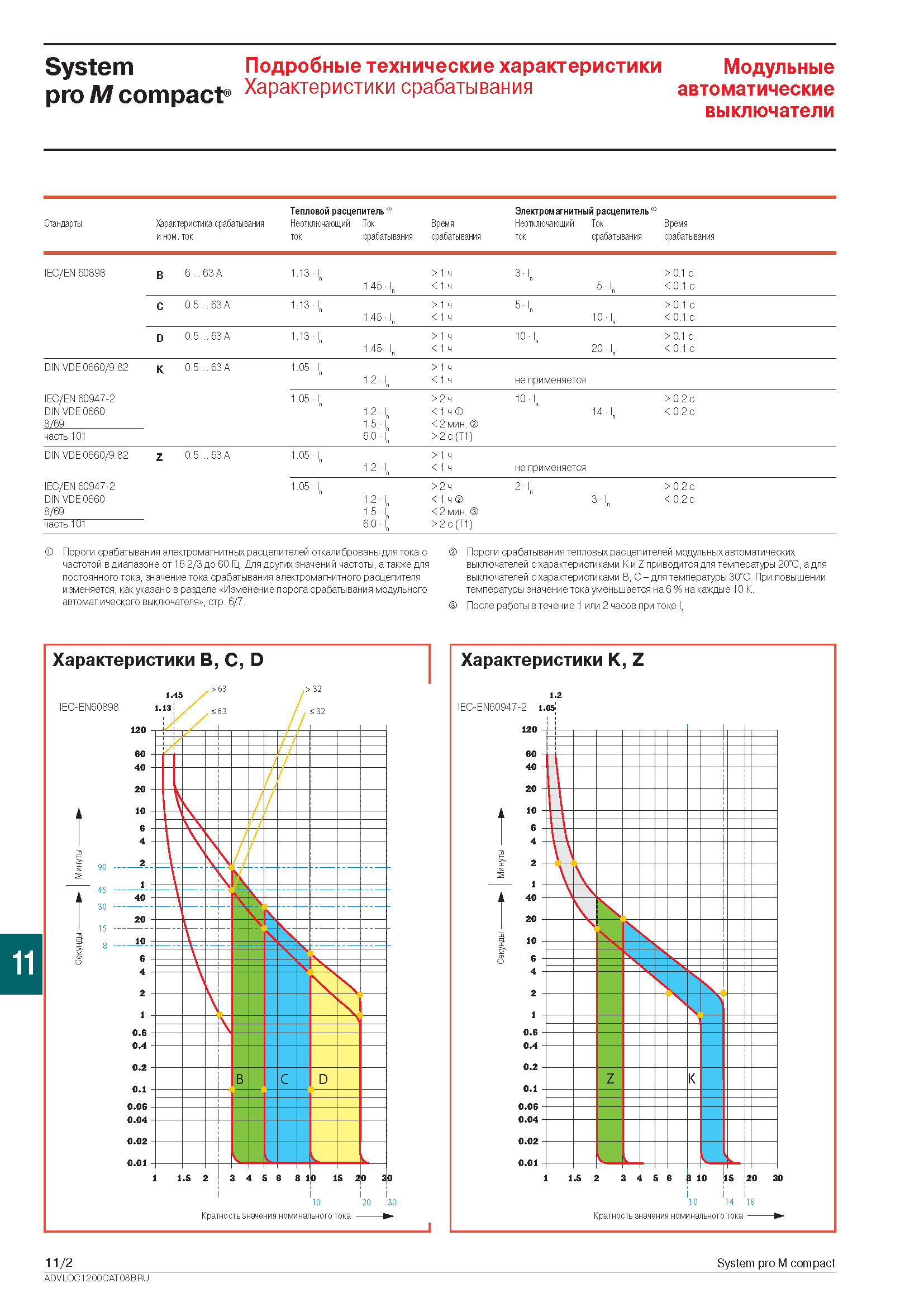
()
Secondly, I found the amendments for temperature and the number of devices nearby interesting. Interesting, because some comrades from some, ahem, offices call in the summer and say: “You know, our machines here have started to turn off. Probably broken. We need to replace it." The wiring is not mine, I didn’t do anything there, but I know that their lines are overloaded, the machines are warm, and the heat only adds to the goodies.

()
And correction for the number of devices:
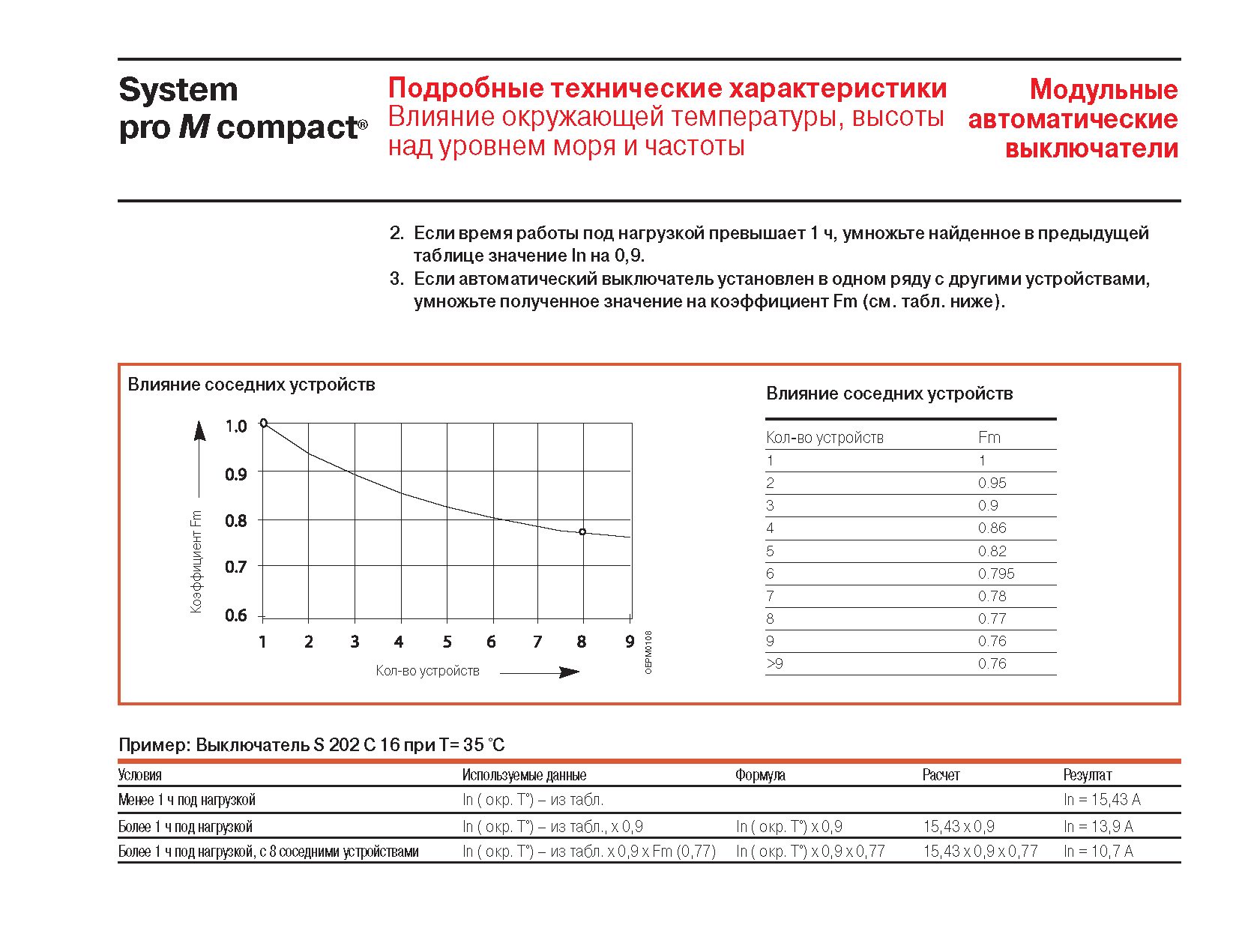
()
So, let's start to figure it out. First and most important. THE MACHINE DOES NOT PROTECT THE LOAD (from short circuits or something else). THE MACHINE PROTECTS THE SUPPLY LINE (CABLE)! You need to put this in your brain! The machine doesn’t care what’s there after the cable. Its task is to save the cable from overload, overheating and fire. That's why right choice The ratings and parameters of the cable, machine and sockets must be in the following sequence:
- We look at the loads that we need to power. How much power do they consume, and therefore how much current will flow through their supply line. To convert current into power, you can use the most common formula: P=U*I, where P is power, U is network voltage (220 volts in the case of an apartment), and I is current. That is, for the current it will be like this: I = P/U. In fact, this formula is only valid for resistive loads such as ordinary light bulbs, heaters, and kettles. But for our case, you can very roughly use it with other devices.
- To power our load we need cable line(piece of cable). Which one? We look at the total total current that we need and select the required cable cross-section (as soon as I find a normal table, I’ll post it). For an open installation, you can very roughly estimate that 1 sq. mm of cable = 10A. For a hidden one, I count “for centuries and with a reserve” as 8A/sq.mm. We look at the section and round it towards the nearest from the standard series: 1.5; 2.5; 4; 6; 10.
- We choose the machine so that it turns off before our cable gets damaged. That is, we look at what currents the machine will turn off, and we look at the maximum current through our cable. If the cable does not roll, we take a larger cross-section and recalculate it.
Second. Let's take a closer look at the machine. The machine consists of two releases. Thermal and electromagnetic. Thermal release- this is a bimetallic plate that heats up when current flows through it, with severe overheating it bends, releases the lever inside the machine, and the machine turns off. The purpose of a thermal release is to react slowly and protect the line from overloads. It will work just when you connect five heaters and a dozen kettles. In this case, too much current (for it) will flow through the cable, and it may catch fire. In this case, the thermal release “wait” for some time (what if the overload is short-term) and turns off the line, saving it.
Electromagnetic release designed to protect against short circuit. In this case, the current in the line will be very large compared to a normal overload (tens of times), and the line must be turned off instantly. For this, a conventional electromagnet is used: a coil of wire and a core, which again activates the mechanism of the machine, causing it to turn off. A huge current flowed - the electromagnet retracted and cut off the line.
But then things start to get interesting. In the description and inertia of the protection, I said that in some cases a short-term departure of a parameter outside the norm may not be particularly critical, and the protection in this case should not work too paranoidly. This rule also applies to slot machines. It turns out that when you turn on a motor, for example a vacuum cleaner or a country pump, a fairly large surge of current occurs in the line, again several times higher than normal. Of course, according to the operating logic, the machine should turn off. Well, for example, the motor in operating mode consumes 5A, and in starting mode - 12. The machine, for example, costs 10A, and from 12 it should turn off. What to do? Set the machine to 16? But then if something happened - the motor jammed, the cable shorted - who knows whether it will turn off or not. And the smaller one will of course protect the line, but will be triggered by every sneeze.
So you don't have to worry about it, smart people came up with such a thing as " characteristics of the machine". It's correctly called " Time-current characteristic“, but in jargon it is usually simply a characteristic or category of shutdown. It is indicated by that same inconspicuous letter in front of the rating of the machine, which usually everyone wanted to give a damn about:) There are B, C, D and for special perversions - K and Z. This characteristic shows the current and time at which the electromagnetic release of the machine will operate. Here are the three main ones:
- B: 3-5 par
- C: 5-10 denominations
- D: 10-20 denominations
Characteristic B is the most sensitive and is indicated for use in apartments and residential buildings, where the loads are more active, and some powerful engines rarely turn on. Characteristic C is the most common (that’s why it also works, hehe, for residential buildings), and is suitable for general cases. And characteristic D is precisely designed for powering some evil machines, large motors and other devices where there can be large overloads when they are turned on.
So it turns out that for our native machine in C16, the current range at which it turns off instantly (~ 0.1 seconds) will be 80-160 A. That's it! Are you going to hang it on a frail cable? Well, the cable is also not a fool and can withstand short-term overloads.
But let's get to something more interesting. thermal release. As we remember, it is designed to protect the line from long-term overloads. That is, the machine does not have to turn off immediately, and in this case time it does NOT turn off may amount to some HOUR, or even more. Let's check out the catalogue, again for the C16. By the way, for all characteristics B, C, D the parameters are the same, so I will give a list for common machine denominations.
Shutdown time MORE THAN AN HOUR:
- 6A: 6.78A
- 10A: 11.3A
- 16A: 18.08A
- 25A: 28.25A
And now it's time to unplug. LESS THAN AN HOUR(but does not mean that it’s not exactly the hour):
- 6A: 8.7A
- 10A: 14.5A
- 16A: 23.2A
- 25A: 36.25A
So, turning off for an hour means, in the worst case scenario, that the machine will warm up for an hour, hold a current of 23A (for a nominal value of 16A) and only then turn off. Dear and hated (I'm tired of seeing it on sockets!) I bring the 25A rating specifically to laugh about the fact that before you turn it off, your 2.5 sq. mm cable will fucking burn out. This is a bug that everyone usually forgets about, and it is this that determines the required cable cross-section. Because the cable must hold the above current for an hour.
Let's do the math, just for fun. We take a 16A machine and a 2.5 sq. mm cable. For this cable, let’s say the maximum continuous current will be 2.5*10 = 25A. At the same time, it will heat up quite noticeably. And the long-term current for laying in the wall will be 2.5 * 8 = 20A. This is if the cable is poorly cooled, lies behind some lining in wooden house. Let's consider, so to speak, the worst case. Let’s look at the machine again: a 16A machine holds a current of 18A for more than an hour, and 23A for less than an hour. The worst option is more than an hour, 18A. The weakest current of the cable is 20A. 20>18, which means the cable can be used. Well, a simpler explanation for clients in a tank is usually this: “But you see 16A written on your socket? That means the machine also needs 16A.” And indeed it is! And what about our dear denomination 25A, which everyone loves to use if 16A is not enough and for some reason (what a bastard!) it knocks out? And there the non-shutdown current for more than an hour is 28A. This means that while the machine deigns to turn off, your cable itself will be such a good stove.
Let's try to check the second reasonable crap, that for a 1.5 sq. mm cable the machine should have no more than 10A. 1.5 sq. mm this is either 15A or 12. A 10A machine has currents of 11 or 14A. You don’t even need to look - let’s go for a ride. And if you consider that now there are either, or vice versa, cables with a greatly reduced cross-section, then I strictly insist on the following:
- For a 1.5 sq. mm cable, the machine is no more than 10A
- For a 2.5 sq.mm cable, automatic no more than 16A
You can try to calculate other cables. I succeeded further in increasing order. That for 4 sq. mm you need 25A, and for 6 - 32. In practice, it turns out that due to the inertia of the thermal release of the machine, with a fully loaded line in C16 for all its 16A, it will be possible to boil the kettle in another 5 minutes and nothing will turn off .
Now it’s clear why my hair stands on end in all parts of my body when I see some kind of sign with the signature “room sockets” and a denomination of C25? Well, if you also have summer heat, then it turns out that at 50 degrees of heat, a 16A automatic machine will turn into 14.1 A. That’s some interesting arithmetic!
If you are interested in the information from this post and want to contact me (or order / ), then write me an email or call me at +7-926-286-97-35
. I answer to the name "Electroshaman".
I will harshly mock inattentive, stupid and arrogant salespeople and managers if they do not look into, but rather rush to call.
A sixteen-amp circuit breaker, which can be designated as a 16 A electric circuit breaker, belongs to the type of switches medium power With rated current 16 amperes, regardless of the type of time-current characteristic and the number of poles of the machine. The 16A automatic machine is very often used in everyday life and in industrial settings.
The article number of the machine usually contains three main parameters that are important for use in automation, and as shown in the example in the image, first comes the number of poles of the machine, then the rated current of the machine is indicated, and at the end of the article the designation of the time-current characteristic is indicated.
The number of design options for a 16A circuit breaker, obtained as the number of possible designs by the number of poles equal to four multiplied by the number of possible designs by the type of time-current characteristic equal to three, is equal to twelve machines that make up a series of modular circuit breakers with a maximum short-circuit current of 4.5 kA.
Power 16A automatic circuit breaker
A 16A automatic machine can maintain maximum for a long time full power load connected to the electrical wiring protected by a sixteen-amp circuit breaker is 3.5 kW in the case of single-phase power supply alternating current with a voltage of 220 volts and active load. Three and a half kilowatts corresponds to the rated current of the machine equal to 16 amperes, with high currents flowing for a long time through the circuit protected by the machine, the 16A automatic fuse will operate and turn off the power in accordance with its time-current characteristic.When connecting a 16a circuit breaker to protect a three-phase electrical circuit, the full long-term power circuit breaker can reach 11.6 kW, which is the same 3.5 kW per phase pole of the circuit breaker when connecting the load according to any scheme, with the exception of a three-wire connection according to a delta diagram, which allows you to connect a larger load.
When connected three-phase load triangle, a total power reaching 18.2 kW (6 kW per pole) can be obtained by electrical appliances powered by wiring protected by a 16A circuit breaker, despite the same 16A force flowing through each pole of the circuit breaker.
Application of 16A circuit breaker
A 16-amp circuit breaker, also sometimes called a sixteen-amp circuit breaker, is one of the most popular types of circuit breaker used in everyday life. The popularity of the 16A machine is connected, on the one hand, with its sufficiently large power to provide electricity small apartment or a house, on the other hand, with a small installed capacity, permission to connect which is given by energy services quite easily.An automatic fuse, depending on the polarity of the design, is used as an input circuit breaker, the two-pole modification of which (phase and neutral) is installed in front of the meter on a two-wire electrical wiring, as a line protection circuit breaker, the single-pole version of which is installed on phase wire extending from the electrical panel to the wiring that supplies both the outlet and lighting power lines. In addition, a 16A single-pole and two-pole circuit breaker can protect the dedicated power line of some separately connected electrical devices, such as storage boiler(there is not enough power for a flow-through machine), a washing machine, dishwasher and others, with consumption up to 3.5 kW electrical appliances.
Separately, we can note the use of a 16A automatic fuse in three and four-pole versions as an input circuit breaker when three-phase circuit power supply to a residential property (house), which does not happen too often, but allows you to remove more power and connect not too powerful three-phase energy consumers, for example an electric motor, for domestic needs.
Single-phase and three-phase options 16A machine. In this case, three-terminal circuit breakers with a D curve are relatively often used, used to power electric motors.
Control electrical energy possible using special switches with one or more active poles. Depending on the needs, a two-pole or single-pole circuit breaker is often used for this.
Single-pole switches (IEK) GOST R 50345-99 are an important part of the electrical distribution system, as they help to safely control branches from the distribution panel. They are primarily used to supply 120 volts of power, while the two-pole ones supply 240 volts to the circuit. Single-pole circuit breakers are available in a wide range; in the store you can buy 16, 20 and 30 Amp circuit breakers. The most common single-pole circuit breakers are 16A and 25A.
Photo - ABB single-pole circuit breaker
The circuit of a single-pole switch, like a two-pole switch, is designed to protect electrical networks and devices connected to them. A differential device (difavtomat) turns off the load when it exceeds permissible norm. In this case, a power outage can also occur at the time of a short circuit in the system, or if the parallel network is overloaded.
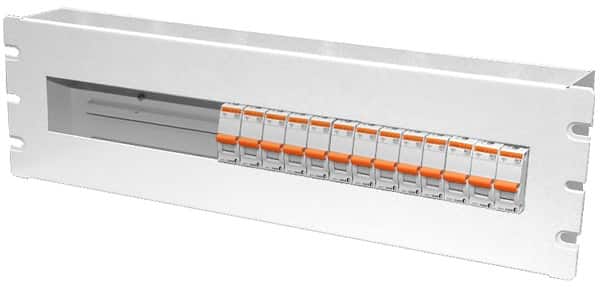
Photo - instrument housing with single-pole circuit breakers
This required device at the dacha or at home. Advantages single-pole RCD with independent connection:
- Protection electrical appliances from power surges. The device also controls the number of devices connected to local network, and if an overload occurs, it stops the current supply. If this were not done, there would be a possibility of a wiring fire;
- Protection of wiring in the apartment from overload;
- Affordability - the device is cheaper than a two-pole electric machine.
Some contactors are also equipped with a thermal response mechanism. They are called single-pole thermomagnetic circuit breakers. Such systems can be installed in networks that, when overloaded, heat up and can catch fire.
Specifications
Naturally, each model has certain power and throughput parameters. We suggest you consider specifications automatic single-pole circuit breaker type ABB (ABB):
- Initial network voltage – 230–400 V;
- Rated (initial) current – 16A;
- Frequency – 50Hz;
- Capacity (up to a switch with a power of 60 A) – at least 4.5 kA;
- Operability up to 10 thousand shutdowns and starts;
- Guaranteed circuit strength - up to 10 thousand shutdowns and starts;
- There is one pole (hence the name “single-pole”), in contrast to a two-pole machine, which, accordingly, has two of them;
- Class fire safety and protection against penetration of vapor and solid particles under the body - 20IP;
- The maximum connection wire size is 25 mm 2 ;
- Shutdown speed - less than 0.1 seconds;
- The current determines the certificate of a specific device.
From this series, the BM40 automatic modular switch is most often used. It is known for its ability to pass up to 32 Amperes, while providing a maximum number of operating cycles (switching off - switching on) - up to 30. The Legrand brand machine also operates in a similar way, Schneider electric Multi9 (25 A), Merlin Gerin and ABB SH201-B6.
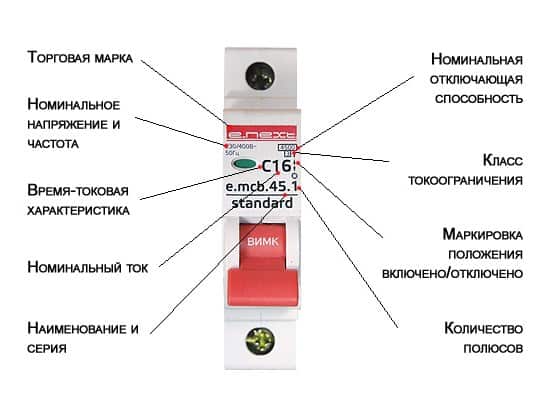
Photo - marking of single-pole circuit breakers
In addition, a single-pole circuit breaker is also divided into kinds:
- A – this type is used to connect a group load in residential buildings or apartments, used in domestic conditions;
- B – used to protect networks that are connected to heavy loads. Most often these are personal lighting or homes with increased energy consumption needs. Used in systems with a ratio of 3÷5 In;
- C – required for connection industrial buildings, factories, companies and other industrial networks.
Video: Connecting a single-pole circuit breaker
Installation of a single-pole circuit breaker
Let's look at how to connect a single-pole circuit breaker to a DIN rail:
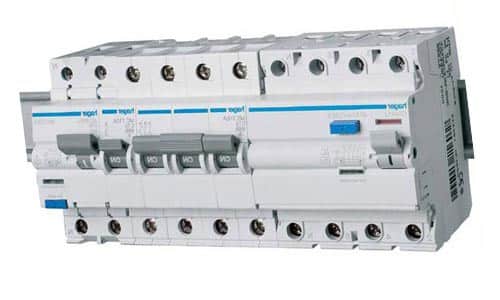
Quite often, home electricians use circuit breakers with a special release. A device with such a mount can be removed from the DIN rail and other surfaces very quickly, since it can be removed by simply pressing the installation “crocodile”.

Photo - the principle of connecting RCD machines
If you cannot connect the contactor yourself, we recommend that you seek help from specialists. Installing a single-pole circuit breaker will cost approximately 150–200 rubles (the price may depend on the specific electrical company).

Photo - principle of installation of circuit breakers
Remember, before installing or changing any circuit breaker (with one or more poles), you must obtain permission from your energy supply company. Otherwise you may be fined. It is also recommended to first professional electrician agree on the parameters and technical characteristics of the selected contactor.
Price overview
In order to buy a single-pole circuit breaker, you need not only to calculate the installation parameters you need (load, throughput, shutdown speed), but also dimensions. Approximate prices for different types machines:
Models produced in Russia and the CIS countries are not inferior in quality and performance, but are much cheaper. You can order directly from the factory or by visiting official dealers.
You can buy machines at any electrical tools store in St. Petersburg, Moscow and other cities. Before you choose the desired model, be sure to check its passport and quality certificate to protect yourself from counterfeits.
No, dear reader, today we will not talk about choosing a manufacturer, although, I will not hide, I am partial to this trio in the photo. Today I will try to tell you how to choose the parameters of machines based on the conditions of their use. The choice of circuit breakers must be approached as responsibly as possible, since it is these humble workers of electrical networks that bear the brunt of most emergency situations.
Any serious manufacturer (or anyone who wants to appear serious) points to front side The body of the machine gun has several obscure, but very important designations. Let's look at the photos:
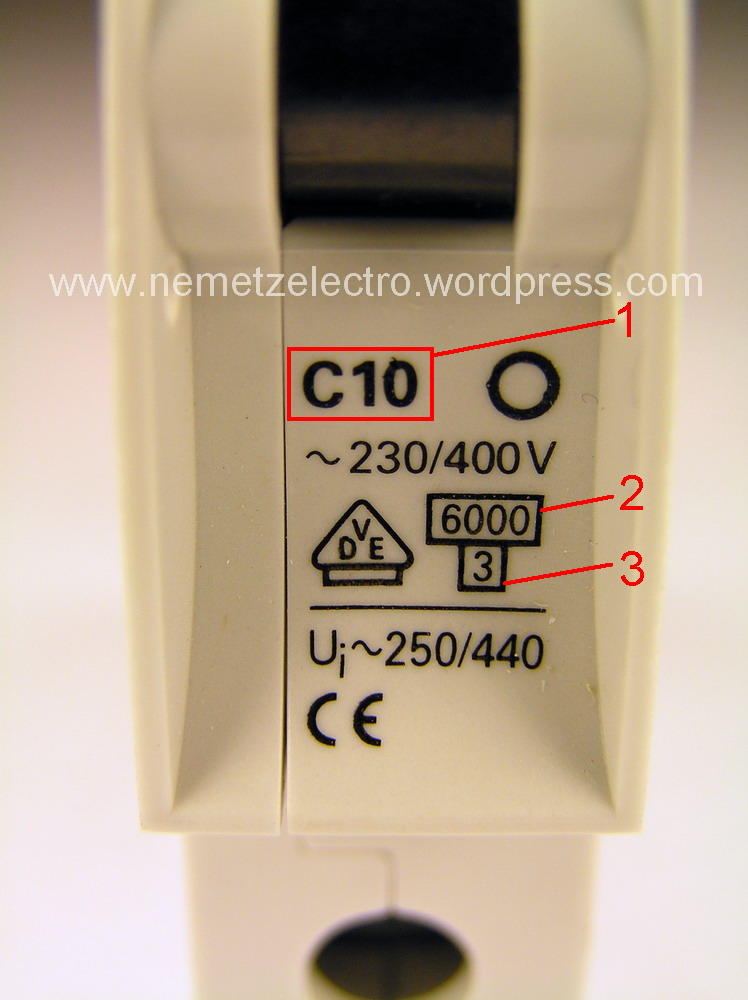
The numbers 1,2,3 mark the same type of symbols on the machines different manufacturers. What are they talking about? Let's sort it out in order. If some words and abbreviations are not clear, take a look. And be patient, dear reader, this article will be long. So:
DIGIT 1
In the photographs, the number 1 indicates the rated current of the machine, measured in amperes. This the most important parameter circuit breaker. We don’t pay attention to the letter to the left of the rated current for now, more on that later.
What exactly is a circuit breaker for? That's right, for protection, but protection of what? Perhaps household appliances? No. Household appliances he is not obliged to protect. The machine protects the wiring. And it is precisely that section of the wiring that is connected AFTER the machine, and not BEFORE it. Wiring can be done with cables of different sections, and accordingly, long-term current can withstand different ones. The task of the machine is to prevent a long-term flow of current exceeding the permissible for of this cable size. What do PUEs say about this?
Table 1.3.4. Permissible continuous current for wires and cords with rubber and polyvinyl chloride insulation With copper wires| Conductor cross-section, mm 2 | Current, A, for wires laid | |||||
| open | in one pipe | |||||
| two single core | three single core | four single core | one two core | one three core | ||
| 1,5 | 23 | 19 | 17 | 16 | 18 | 15 |
| 2,5 | 30 | 27 | 25 | 25 | 25 | 21 |
| 4 | 41 | 38 | 35 | 30 | 32 | 27 |
| 6 | 50 | 46 | 42 | 40 | 40 | 34 |
| 10 | 80 | 70 | 60 | 50 | 55 | 50 |
| 16 | 100 | 85 | 80 | 75 | 80 | 70 |
I edited the table, removing from it sections that are not used in everyday life. The cooling conditions for a cable laid in a groove are almost the same as when laid in a pipe. A three-core cable with a protective PE conductor should be considered here as two-core, since in normal mode protective conductor no current flows. Therefore, we are interested in the penultimate column of the table (highlighted in red), which indicates the permissible continuous currents for a two-core cable laid in a pipe. Everything seems clear; a cable with a cross-section of cores of 1.5 square is protected by a 16A circuit breaker (the closest standard rating is 18A), 2.5 square - 25A, and so on...
But it was not there! In the USSR it was possible to buy a cable with a core cross-section of 2.5 square meters declared by the manufacturer and be 100% sure that it was so. Now “effective managers” are ready to do anything to extract additional benefits. And the vast majority of cable products come with a reduced core cross-section. Let's say you bought a cable with a cross-section of 2.5 square, measured the diameter of the core with a micrometer, calculated the area of the circle and realized that, to put it mildly, you had been deceived. The actual cross-section of the core turned out to be, for example, 2.1 square.
But that is not all. Was the cable sold to you as copper? Electrical copper should be reddish in color, bend easily and not spring back. Now look what you have in your hands. Do the veins have a yellowish tint, bend with effort and are clearly springy? Congratulations . The manufacturer also saved on chemical composition lived It is no longer copper, but rather brass. And the electrical conductivity of brass is lower than that of copper.
What to do? Well, first of all, not all manufacturers cheat. There are, for example, Rybinskelectrokabel or Kolchuginsk Elektrokabel, which produce honest GOST products. True, it will be more expensive. And you won’t be able to buy it in Yaroslavl on a whim; you have to order it. If necessary, we will do it, I also have a discount. If you need something cheaper, you can buy it in specialized stores; the cable there is also of quite acceptable quality; there is no such thing as an outright leftist. The main thing is not to buy a cable in a grocery store, stores that sell everything from flower pots to cars.
But let's return to the topic of our conversation. Let's say the cable you purchased is, so to speak, not entirely honest. Nothing wrong with that. You just need to reduce the machine's rating by one level. For example, if according to table 1.3.4 for a cable with a core cross-section of 2.5 square permissible current 25A, then we will supply a machine with a rating of 16A. For a cable with 6 square conductors, the table allows 40A, but we will install a 32A machine. In short, it's better to be a little safe. But this is not just a matter of reinsurance. There is another good reason for reducing the rating of the machine by one step from the table value. More about her later.
Let's briefly summarize this part of the article, matching the cross-section of the cable cores and the rating of the circuit breaker, taking into account reasonable reinsurance and the scope of application:
Let's continue talking about the number 1 in the photos. Now let's talk about the letter to the left of the designation of the rated current of the machine:

This letter indicates the characteristics of the electromagnetic (instantaneous) release. For those who are not familiar with the design of a circuit breaker and do not know what an electromagnetic release (EMR) is, please... The emr is triggered when a short circuit current (SCC) occurs. But the machine must be able to distinguish shortness from overload. For example, a current of 25A flowed through a machine with a nominal value of 16A. This is an overload, but not a short circuit current. The thermal release (TR) bimetallic plate heats up and causes the machine to turn off. But this takes time; TR cannot work instantly. And if the current is not 25, but 200A? Now this looks like a short one. While the TR is working, a fire may start! This is where the EmR comes into play and will force the machine to turn off immediately.
Where is the boundary beyond which the EM should regard the overload as a short circuit and instantly turn off the machine? The letter to the left of the designation of the rated current of the machine indicates this boundary. It's called characteristic electromagnetic release. This letter indicates the multiple of the EmR cut-off current (Iots) in relation to the rated current of the machine (In). That is, the ratio Iots/In . These letters may be different, but the three most popular are:
Letter "B". Iots=3…5In
Letter "C". Iots=5…10In
Letter "D". Iots=10…20In
Let's look at two examples:
Example one. A current of 100A flowed through a circuit breaker with a rated current of 16A and characteristic “C” (C16). Will the cut-off (EMR) work or will the machine take time to operate the TR? We multiply the rated current of the machine by the multiplicity factor corresponding to the “C” characteristic (in calculations, for reliability, you should use highest value multiplicity factor from the range for the corresponding characteristic; if for characteristic “C” the range is 5...10, in the calculations we take the coefficient value equal to 10):
16x10=160A
The electromagnetic (instantaneous) release of the C16 machine will operate at a current of no less than 160A. But our current through the machine is 100A. Means what? That's right, EmR will not work in this example and we can only rely on TR.
Example two. The conditions are the same as in the previous example, but the EmR characteristic is no longer “C”, but “B” (automatic machine B16):
16x5=80A
The minimum operating current of the EMR in this case is 80A. And we have 100A leakage. Therefore, we have a reserve of 20A and the cutoff will surely work; the machine will turn off instantly.
For clarity, I stole this picture from the Internet:

The picture is called “Time-current characteristics of the circuit breaker.” Knowing how many times the current through the machine is greater than its nominal value, you can use it to determine the response time. In the picture, the area of operation of the electromagnetic release is indicated in light gray, and above it is the thermal release, in a darker color. Again a few examples:
1. The current through the machine is twice its nominal value. From the picture it follows that the machine with any characteristic will turn off in the time interval from 10 to 50 seconds.
2. The current through the machine is eight times higher than the rated current. The machine with characteristic “B” will turn off in 0.01 seconds, and the EMR will work. And the machine with characteristic “C” will work in the time interval of 0.01...3 seconds. Remember the cut-off current multiplicity interval of 5...10In for characteristic “C”? In our example, we have an eight-fold overload lying within this interval. Therefore, the response time will depend on the specific instance of the machine. For one machine, the EmR will work (0.01 seconds), for another it will not, and the machine will have to be turned off thermal release in 3 seconds.
3. The current through the machine is 15 times higher than the rated current. Here, machines with characteristics “B” and “C” will work instantly, and a machine with characteristic “D” (cut-off current multiplicity interval 10...20In) can work instantly, or maybe take 2 seconds. Again, this will depend on the specific instance.
4. Thirty times the rated current. Specific shorty! In this case, all three machines (“B”, “C” and “D”) “click” immediately.
But that’s not all the “interestingness” of this picture. Do you see two lines in the upper left corner going up and next to them two numbers - 1.13 and 1.45? This is very interesting numbers. These are the overload ratios at which the machine operates in a time of more than an hour (1.13) and less than an hour (1.45). In other words, if the overload is less than 1.13, then the machine will not work at all. If in the range from 1.13 to 1.45, then it will work in more than an hour. And if the overload factor is more than 1.45, for example, 1.6, then the machine will operate in less than an hour.
Let's go back a little to choosing the rated current of the machine. Remember table 1.3.4? Let's calculate what will happen if we blindly use this table and don't think with our heads. For a cable with 2.5 kV cores when laid in a groove, the table allows a continuous current of 25 A. We turn off our brains and stupidly put a 25A machine on this line. And then we arrange an overload; Let's say 1.4 times. 25x1.4=35A! And the time-current characteristic tells us that the machine will take more than an hour to operate under such an overload. That is, for more than an hour a current will flow through the cable that is almost one and a half times the maximum permissible! What if, in addition, the cable is laid in such a way that its cooling conditions are unimportant, for example, in a corrugation or in a layer of insulation, or both at the same time? We also don’t forget that the cable may have a reduced core cross-section. What will happen in the end? Let's fry the cable! A fire will most likely not happen, but degradation of the insulation will inevitably occur, which will make itself felt in a few years. And if such overloads occur regularly, then much sooner. This is another reason to reduce the rating of the machine by one step from the table value. Hello, jamshuts, sculpting 25A machines on socket lines! I repeat especially for you:
1.5 sq.mm. – 10A. Lighting lines.
2.5 sq.mm. – 16A. Socket lines.
4 sq.mm. – 25A. Lines instantaneous water heaters moderate (up to 5 kW) power.
6 sq.mm. – 32A Lines of electric stoves or high-power instantaneous water heaters; entry into apartments with gas stoves.
10 sq.mm. – 50A. Entry into apartments with electric stoves.
By the way, there is one more nuance. Most ordinary household sockets are designed to connect to them conductors with a cross-section of 2.5 squares. But the permissible current indicated on the socket is 16A. Therefore, the machine must have a rating of no more than 16A, despite the fact that Table 1.3.4 allows for a long-term current of 25A for a cable with 2.5 square conductors. Appliances, having a regular plug designed to be plugged into a regular socket, never have a power greater than 3.5 kW, which means they easily fit into the 16A limit.
But let's return to the characteristics of the electromagnetic release. How to correctly choose this very letter to the left of the rated current of the machine? It is clear that we need to strive to ensure that the machine’s EMR is reliably triggered when a fault occurs. In other words, the product of the rated current of the machine and the multiplicity factor must be obviously less than the short-circuit fault that may occur in the protected section of the network. And the higher the TKZ, the more confidently the machine will work. But what does the expected TKZ depend on? Just three factors:
1. Network length. The greater the distance from the transformer substation to your home, the further your entrance from the house ASU and the higher your floor, the smaller the expected TKZ will be.
2. Conductor cross-section. If the risers of your house are laid aluminum wires with a cross-section of only 6 squares, and in a “noodle” APPV apartment with a cross-section of 2.5 squares, you shouldn’t count on a large TKZ.
3. Connection status. A bunch of “snotty” twists in the floor panels will also reduce the expected TKZ.
Exist special devices to measure the expected TKZ. Their price tag is inhumane, so they are inaccessible to most home craftsmen. But when choosing the characteristics of an electromagnetic release, you can be guided by several simple rules:
Characteristic "B". It is preferable in old housing stock, where the reconstruction of in-house electrical networks has not been carried out. Also, in rural and country houses receiving power from air lines, having a large extent. It should be noted here that the price of machines with characteristic “B” is slightly higher than with characteristic “C” and they are not available for free sale, they are a special order item. But again, dear reader, if necessary, we will do it.
Characteristic "C". Machines with this characteristic are the most common and commercially available. They can be used in electrical networks that are in satisfactory condition.
Characteristic "D". Due to the high cut-off current ratio (10...20In), such machines are used in industry to protect lines with high inrush currents that arise, for example, during startup powerful electric motors. But they have no place in everyday life! This is what GOST 32395-2013 “Distribution panels for residential buildings” says:
“6.6.5 Automatic circuit breakers ..... must have short-circuit current releases (electromagnetic, types B, C)”
As you can see, characteristic “D” is unacceptable in residential buildings.
Well, dear reader, we have figured out the rated current of the circuit breaker and the characteristics of the electromagnetic release. Now let's move on to number 2 in the photos.
DIGIT 2
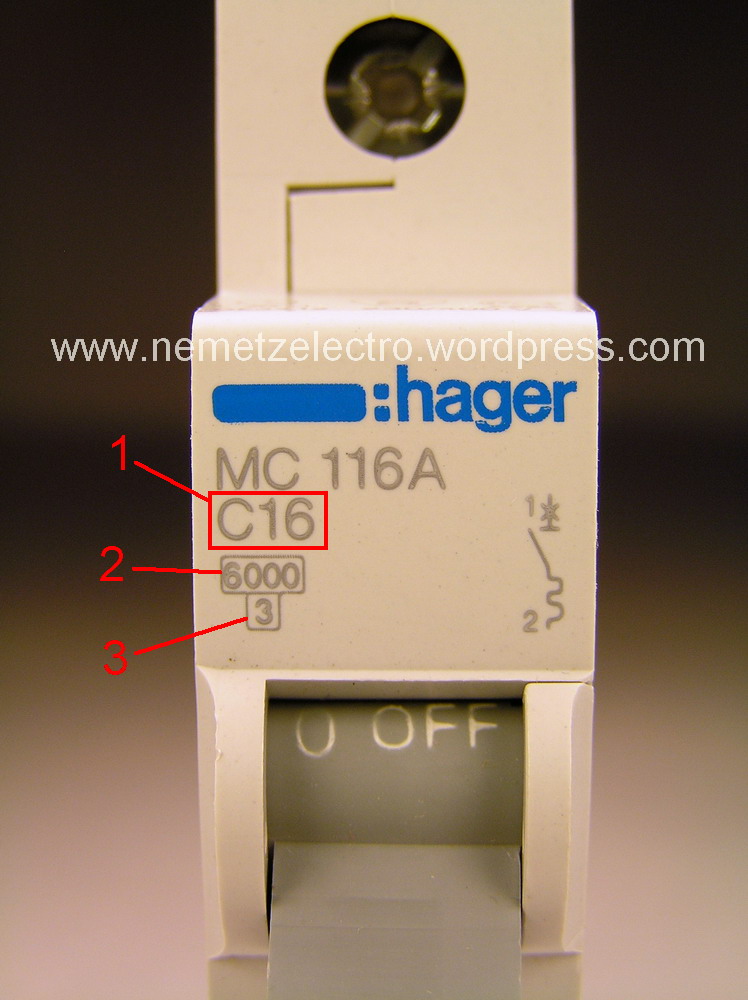
In the photographs, the number 2 indicates the breaking capacity of the circuit breaker (OS), measured in amperes. This is the maximum short-circuit current that the machine can turn off while maintaining its functionality. Above I said that in the old housing stock, in rural areas and in dacha villages the expected TKZ does not reach large values and to ensure protection it is necessary to use circuit breakers with characteristic “B”, that is, with more sensitive EMs capable of responding to a relatively small short-circuit current.
But the situation can be just the opposite. If you have a new building apartment, risers are in the entrance large section, and the substation is located right in the yard, the expected TKZ can reach very large values, up to 2000...3000A! The machine will, of course, work, but when its contacts diverge, a powerful arc will arise between them, which will need to be extinguished immediately. The ability of the machine to extinguish an arc caused by a short circuit is indicated by its breaking capacity.
The breaking capacity can be 3000, 4500, 6000 and 10000A. By the way, machines with OS 3000 and 4500A are prohibited for use in the European Union. European companies no longer produce machines with OS 3000A; 4500-amp units are produced, but sold only in the CIS. Actually, there is no crime in this; the circuit breaker with a breaking capacity of 4500A is suitable for use in residential buildings. Here is an automatic machine from ABB model SH201L with OS 4500A:
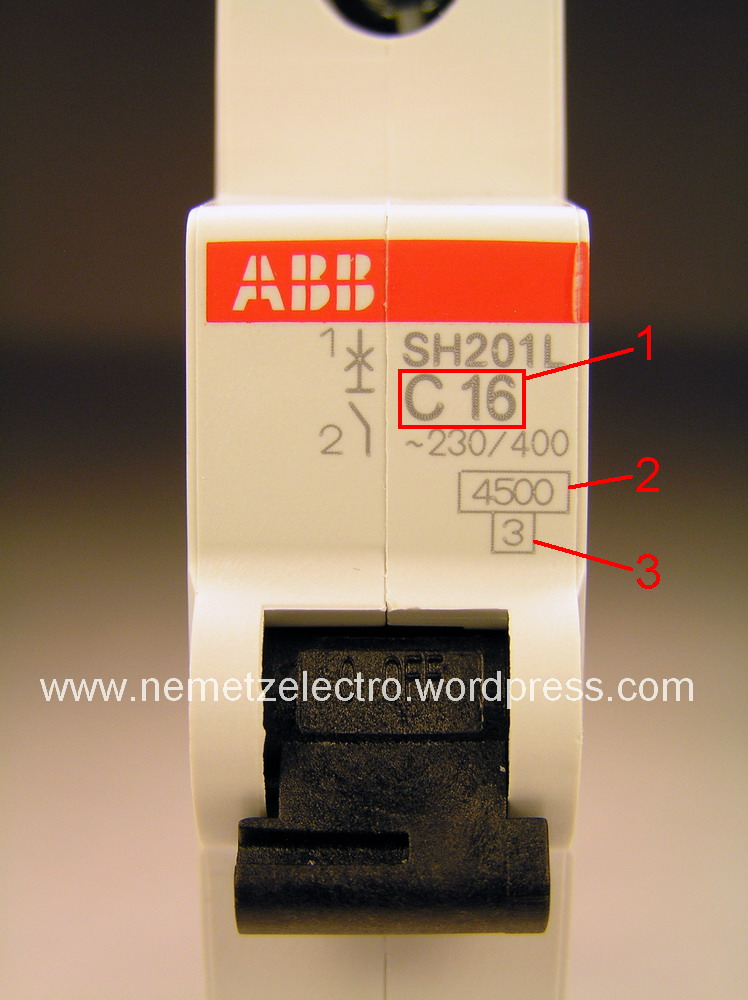
ABB calls this series “Compact Home”, that is, it is intended for use in residential construction.
But I still prefer to use circuit breakers with a breaking capacity of 6000A. The fact is that the higher the breaking capacity of the machine, the longer its resource. And considering that the difference in the price of machines with OS 4500 and 6000A is only about 20 rubles, meager savings on your own safety are inappropriate.
And finally, dear reader, we get to number 3 in the photos.
DIGIT 3

Number 3 in the photos indicates the current limiting class. What is it?
Let's imagine how the machine operates when a short circuit occurs:
1. The short circuit current causes an increase in the magnetic flux in the coil of the electromagnetic release.
2. The coil core moves under the influence of it magnetic field and affects (provokes) the release mechanism of the contact group.
3. The release mechanism operates and opens the contacts.
4. The arc that occurs between the contacts is extinguished by the arc suppression chamber.
It is clear that each of these four stages takes some time. But we have a short one and a huge current flows in the emergency line! This means that the response time of the machine should be as short as possible; The shorter this time is, the less trouble the short one will have time to do. And it is very desirable that the machine operates before the short-circuit current reaches its maximum value.




